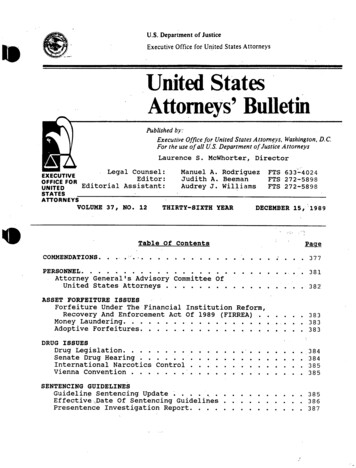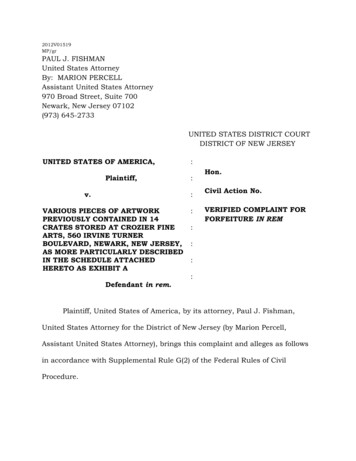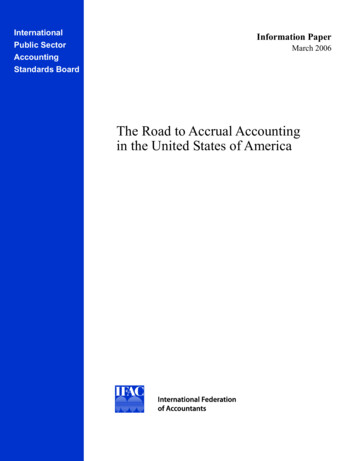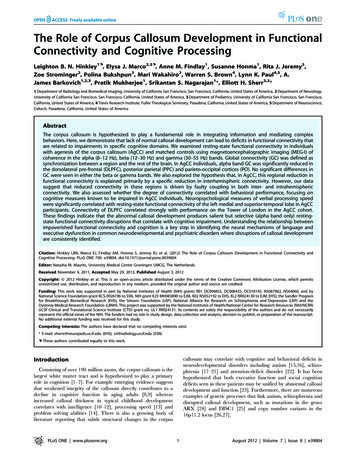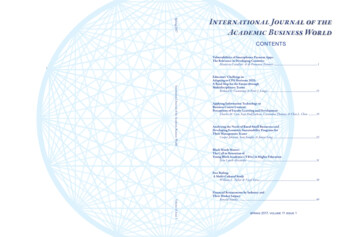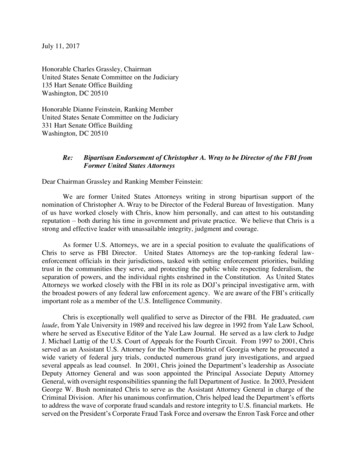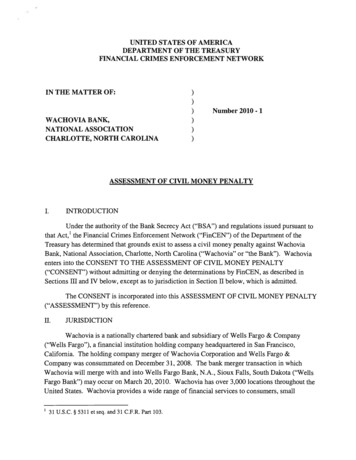
Transcription
UNITED STATES OF AMERICADEPARTMENT OF THE TREASURYFINANCIAL CRIMES ENFORCEMENT NETWORKIN THE MATTER OF:WACHOVIA BANK,NATIONAL ASSOCIATIONCHARLOTTE, NORTH CAROLINA))))Number 2010 - 1))ASSESSMENT OF CIVIL MONEY PENALTYI.INTRODUCTIONUnder the authority of the Bank Secrecy Act ("BSA") and regulations issued pursuant tothat Act,l the Financial Crimes Enforcement Network ("FinCEN") of the Department of theTreasury has determined that grounds exist to assess a civil money penalty against WachoviaBank, National Association, Charlotte, North Carolina ("Wachovia" or "the Bank"). Wachoviaenters into the CONSENT TO THE ASSESSMENT OF CIVll. MONEY PENALTY("CONSENT") without admitting or denying the determinations by FinCEN, as described inSections III and IV below, except as to jurisdiction in Section II below, which is admitted.The CONSENT is incorporated into this ASSESSMENT OF CIVll. MONEY PENALTY("ASSESSMENT") by this reference.II.JURISDICTIONWachovia is a nationally chartered bank and subsidiary of Wells Fargo & Company("Wells Fargo"), a financial institution holding company headquartered in San Francisco,California. The holding company merger ofWachovia Corporation and Wells Fargo &Company was consummated on December 31, 2008. The bank merger transaction in whichWachovia will merge with and into Wells Fargo Bank, N.A., Sioux Falls, South Dakota ("WellsFargo Bank") may occur on March 20, 2010. Wachovia has over 3,000 locations throughout theUnited States. Wachovia provides a wide range of financial services to consumers, smallI31 U.S.c. § 5311 et seq. and 31 c.P.R. Part 103.
businesses, middle-market companies and major corporations. The Office of the Comptroller ofthe Currency ("OCC") is the Bank's Federal functional regulator and examines Wachovia forcompliance with the BSA, its implementing regulations and similar rules under Title 12 of theUnited States Code.At all relevant times, Wachovia was a "financial institution" and a "bank" within themeaning of the BSA and the regulations issued pursuant to that Act. 2FinCEN may impose civil money penalties, or take additional enforcement action,against a financial institution for violations of the BSA and the regulations issued pursuant tothat Act. 3III.DETERMINATIONSA. SummaryAn investigation recently conducted by the Internal Revenue Service, the DrugEnforcement Administration and FinCEN, working in conjunction with the United StatesAttorney's Office for the Southern District of Florida, and a parallel examination andinvestigation conducted by the OCC, determined that from 2004 to 2008, Wachovia violated theanti-money laundering program requirements, suspicious activity reporting requirements, andSection 312 of the USA PATRIOT Act. 4 Appearing below is a summary of the violations of theBSA by Wachovia.The anti-money laundering ("AML") program at Wachovia was deficient in three of thefour core elements required by 31 U.S.C. § 5318(h)(1) and 31 c.F.R. § 103.120. Namely, theBank failed to: establish and implement effective internal policies, procedures, and controls;designate personnel to ensure day-to-day compliance;implement an effective independent audit function to test programs with respectto the BSA, particularly the suspicious activity reporting requirements.Wachovia failed to implement an effective AML program reasonably designed to identifyand report transactions that exhibited indicia of money laundering or other suspicious activity,considering the types of products and services offered by the Bank, the volume and scope of itsbusiness, and the nature of its customers. Wachovia failed to implement a programcommensurate with the risks inherent within its business lines and geographical reach. As aresult, Wachovia failed to timely file thousands of suspicious activity and currency transaction23431 U.S.c. § 5312(a)(2) and 31 c.F.R. § 103.11.31 U.S.c. § 5321 and 31 C.F.R. § 103.57.31 U.S.c. § 5318(h)(l), 31 C.P.R. § 103.120,31 C.P.R. § 103.176 and 31 C.F.R. § 103.18.-2-
reports, thus greatly diminishing the value of the reports to both law enforcement and regulatoryagencies.B. Violations of the Requirement to Implement an Adequate Anti-Money LaunderingProgramFinCEN has determined that Wachovia violated the requirement to establish andimplement an adequate AML program. Since April 24, 2002, the BSA and its implementingregulations have required banks to establish and implement AML programs. 5 The BSA alsorequires that an AML program contain the following elements: (1) a system of internal controls;(2) independent testing for compliance; (3) the designation of an individual, or individuals, tocoordinate and monitor day-to-day compliance; and (4) training of appropriate personne1. 61. Internal Policies, Procedures and ControlsWachovia failed to implement an effective system of internal controls to ensurecompliance with the BSA and manage the risks of money laundering primarily in itsinternational correspondent banking customers' accounts. Wachovia lacked adequate writtenpolicies, procedures and controls reasonably designed to assess the risks of money launderingand ensure the detection and reporting of suspicious transactions.Wachovia's policies, procedures and controls failed to ensure that the Bank gathered andreviewed sufficient information on foreign correspondent account customers to adequately assessrisk and potential for money laundering. A sampling of foreign correspondent customer filesshowed significant gaps and inaccuracies in the Bank's documentation of specific customerinformation, including the nature of the customers' businesses, verification of owner/operatoridentities, and anticipated account activity. Documentation of customer identification was notsubject to adequate quality controls to ensure the accuracy of information. Furthermore, theBank lacked an adequate system for periodically updating customer information. The authorityto establish or amend expected activity profiles was not clearly defined and failed to requireapproval of the BSA officer or senior management.The Bank's enhanced due diligence files were not readily available to key complianceofficials. The Bank also failed to update or conduct periodic reviews of foreign correspondentaccounts, and failed to focus sufficient attention on the accounts and transactions that exhibitedhigh-risk characteristics for money laundering. These deficiencies prevented the Bank fromperforming adequate analysis of the risks associated with particular customers to determinewhether transactions lacked any apparent business or lawful purpose, or were within theparticular customer's normal expected range of conduct.5631 U.S.c. § 5318(h)(1) and 31 C.P.R. § 103.120.Id.-3-
Wachovia also failed to implement an adequate risk-rating methodology that evaluatedcorrespondent customers, based on specific customer information, with balanced consideration toall relevant factors including country/jurisdictional risk, products and services provided, natureof the customer's business, and volume of transactions. Even when the Bank rated certainforeign money transmitters as "high risk" or "very high risk," it did not apply commensurateenhanced due diligence practices and transaction monitoring methodologies to managerecognized risk. These deficiencies impaired the Bank's ability to appropriately assess the risksassociated with particular customers.Wachovia lacked adequate systems and controls to monitor transactions conducted by itsinternational correspondent bank customers for potential money laundering or other suspiciousactivity. Wachovia's automated transaction monitoring systems were inadequate to support thevolume, scope, and nature of international money transfer transactions conducted by the Bank.The automated transaction monitoring systems were designed to monitor internationalcorrespondent transactions at the bank level, and were not designed to readily identify suspiciouselements, "Red Flags" or suspicious activity associated with individual transactions. In addition,the monitoring system's programming, methodology, and effectiveness were not independentlyvalidated to ensure that the models were detecting potentially suspicious activity.7The number of alerts or events generated by the Bank's automated transaction systemswas capped to accommodate the number of available compliance personnel. Each alert or eventon an international correspondent bank generated by the Bank's automated transactionmonitoring system was comprised of as many as 30,000 individual transactions (with an averageof 1,400 transactions per alert), which rendered the monitoring system practically unmanageable.The monitoring system was routinely tuned so that the number of alerts generated by the systemwith respect to international correspondent banks remained constant at around 300 each month.As a result, the Bank instituted arbitrary limits on the flagging and review of transactions forsuspicious activity based solely on the inadequate number of staff available to review thesealerts. There is little record of the Bank ever having conducted analysis to determine whether itsnumber of monthly alerts was appropriate to actual risk and the number and nature oftransactions facilitated. Despite the fact that Wachovia conducted in excess of six million wiretransfers for international correspondent bank customers per month, at times the monitoringsystem dedicated to international correspondent bank wire transactions, which supplemented thesystem that reviewed all customer account activity, generated as few as 80 alerts per month.Evidence suggests that as late as September of 2008, as few as 120 wire alerts were generated bythe Bank's transaction monitoring system relative to its international correspondent bankcustomers. Once the caps were removed from the Bank's transaction monitoring system in April7BSAJAML Examination Manual, page 64,8/24/07.-4-
of 2009, the system began to generate a fluctuating amount of alerts (at times in excess of 500)with respect to international correspondent bank wire transactions.A review of alerts from the primary automated monitoring system used by Wachoviafrom August 1, 2007 to August 31, 2008, determined that a majority of foreign correspondentbank accounts did not generate alerts and were not subjected to detailed transaction reviewdespite the high-risk business profiles and geographies associated with many of the customers.Management failed to document or explain filtering criteria, thresholds, and how bothwere appropriate for the Bank's risks. Management failed to periodically review and update thefiltering criteria and thresholds established for continued effectiveness.The Bank placed greater emphasis on clearing alerts and eliminating backlogs thanreviewing and reporting possible suspicious .activity. In 2008, a unit within the Bank reviewedand cleared a backlog of approximately 5,000 cash alerts generated by the Bank's LargeCurrency Transaction Retrieval System. These alerts were not referred for further review todetermine whether possible suspicious activity needed to be reported, and instead were closedfollowing the filing of a currency transaction report. The 2008 review of these 5,000 cash alertsdetermined that 30% involved round dollar transactions, transactions greater than or equal to 9,000, or consecutive day transactions. A further review of 100 sample alerts determined that85% exhibited indicia of suspicious activity and should have been referred for further evaluation.In addition, the Bank had a practice of clearing cash alerts based solely on a single instance ofstructuring. It was not until the spring of 2008 that the Bank curtailed this practice.a. Failure to Manage Risk of Remote Deposit CaptureWachovia utilized Remote Deposit Capture ("ROC") to process certain deposit itemsfrom its non-United States correspondent accounts. ROC, a deposit transaction delivery system,allows a financial institution to receive digital information from deposit documents captured atremote locations such as financial institution branches, A TMs, domestic and foreigncorrespondents, or locations owned or controlled by commercial or retail customers of thefinancial institution. In substance, ROC is similar to traditional deposit delivery systems atfinancial institutions such as pouch activities. However, ROC enables customers of financialinstitutions to deposit items electronically from locations globally. ROC introduces additionalrisks beyond traditional deposit delivery systems.Prior to and after the implementation of ROC in May of 2005, the Bank failed to identifyand assess certain compliance and operational risks associated with the new system. The Bankdid not implement the computer coding necessary to include items deposited through ROC in itssupplemental AML monitoring of check activity. As a result, the Bank failed to detect, reviewand report large volumes of large denomination sequentially numbered traveler's checks-5-
processed through RDC for its non-United States customers' correspondent accounts. During atwo-year period, the Bank failed to adequately monitor approximately six million checks valuedat nearly 47 billion received through RDC. The Bank discovered this lapse in November of2007 during an internal investigation involving more than one billion dollars in sequentiallynumbered commercial checks, received over a two-year period, from a single customer of one ofits non-United States correspondent accounts. Once discovered, the Bank filed numerousdelinquent suspicious activity reports involving the receipt of tens of millions of dollars insequentially numbered traveler's and commercial checks by way of RDC from its non-UnitedStates correspondent customer accounts.The Bank failed to adequately incorporate policies and procedures and implementsystems and internal controls to manage all of the AML risks associated with RDC. The Bankfailed to allocate adequate compliance resources, and should have performed periodic reviewsand generated risk management reports on the AML monitoring issues associated with theimplementation and ongoing operation of RDC systems and services. The institution failed toconsider whether, and to what extent, it could be exposed to the risk of money laundering andnon-compliance with AML laws and regulations. In particular, the Bank failed to recognize andrespond to the growing use and accompanying risk of RDC by foreign correspondent financialinstitutions and foreign money services businesses. Enhanced due diligence and commensuratesystems and controls for foreign correspondent accounts are necessary if the RDC capture deviceemanates from higher risk foreign jurisdictions, or when a customer is otherwise identified ashigh risk.8b. Failure to Monitor Pouch and Cash Letter ActivityThe Bank failed to adequately monitor pouch and cash letter activity for receipt of largedenomination 1,000 sequentially numbered monetary instruments and commercial checks fromits foreign correspondent customer accounts. A 2006 FinCEN Advisory specifically addressedthe deposits of sequentially numbered monetary instruments at U.S. financial institutions by nonbank exchange houses known throughout Latin America as "casas de cambio.,,9 The Bank failedto adequately respond to several warnings, beginning in December of 2006, relative to the receiptof large volumes of sequentially numbered traveler's checks in pouches from Mexico. The Bankfailed to recognize the risks associated with pouches and cash letters received from jurisdictionswith lax or deficient AML structures.The Bank failed to file timely suspicious activity reports with respect to the receipt oftens of millions of dollars in sequentially numbered 1,000 traveler's checks received from itsforeign correspondent bank customers. On those occasions where the Bank filed suspicious89See USA PATRIOT Act § 312, 31 C.F.R § 103.176.FinCEN Advisory FIN-2006-A003, April 28, 2006.-6-
activity reports, few were filed within the same year of receipt of such instruments. In 2006, theBank filed a total of four suspicious activity reports related to cash letter activity occurringwithin the same calendar year. The majority of suspicious activity reports filed by the Bankreport activity a year after receipt of such items. A number of these reports were filed as manyas three years after receipt of such items. The resulting delays and incomplete informationimpaired the usefulness of the suspicious activity reports by not providing law enforcement andregulators with more timely and comprehensive information related to the tens of millions ofdollars in potentially suspicious transactions.c. Failure to Monitor Bulk Cash DepositsForeign financial institutions maintain accounts at U.S. banks to access the United Statesfinancial system and acquire services and products that may not be available in the hostjurisdiction. During the period from 2004 to 2007, Wachovia repatriated approximately 10billion in bulk cash from Mexico into the United States. Internal discussions at the Bankdemonstrated that employees of the Bank were aware of the 2006 FinCEN Advisory with respectto bulk cash repatriation. lO However, the Bank failed to implement adequate procedures andcontrols to ensure that bulk U.S. dollar deposits received from foreign correspondent customerswere monitored for suspicious activity. Furthermore, on those occasions where employees of theBank identified anomalies in the volume or mlX of bulk cash deposits that should have warrantedfurther review, these anomalies were not brought to the attention of the Bank's Compliance orAML Investigative Services groups. Audits and reviews of bulk U.S. dollar cash deposits by theline of business appeared related largely to discussions of profitability and logistics, withoutregard to BSA compliance or the risks of money laundering.During the period from 2004 to 2008, only one suspicious activity report was filed by theBank relative to the receipt of bulk United States dollars from its foreign correspondentcustomers. The Bank exited the international bulk cash business in 2008.2.Correspondent Accounts for Non-United States PersonsAs amended by Section 312 of the USA PATRIOT Act, the BSA requires that:Each financial institution that establishes, maintains, administers, or manages a privatebanking account or a correspondent account in the United States for a non-United States person,including a foreign individual visiting the United States, or a representative of a non-UnitedStates person shall establish appropriate, specific, and where necessary, enhanced, due diligence10FinCEN Advisory FIN-2006-A003', April 28, 2006.-7-
policies, procedures, and controls that are reasonably designed to detect and report instances ofmoney laundering through these accounts. IIOne of the central goals of the USA PATRIOT Act was to protect access to the UnitedStates financial system by requiring due diligence programs for foreign correspondent accounts.Foreign correspondent accounts, as noted in past United States Senate investigative reports, are agateway into the United States financial system. 12Section 312 of the USA PATRIOT Act added subsection (i) to 31 U.S.c. § 5318 of theBSA. This subsection requires each U.S. financial institution that establishes, maintains,administers, or manages a correspondent account in the United States for a foreign financialinstitution to take certain AML measures for such accounts. In addition, Section 312 of the USAPATRIOT Act specifies additional standards for correspondent accounts maintained for certainforeign banks.On January 4,2006, FinCEN published an interim final rule implementing the duediligence provisions of31 U.S.C. § 5318(i)(1)Y Subsequently, on August 9,2007, FinCENfinalized the regulation, and in doing so implemented the enhanced due diligence provisions withrespect to correspondent accounts established or maintained for certain foreign banks.14The term "foreign financial institution" includes: A foreign bank;Any foreign branch or office located outside the United States of any U.S.broker/dealer in securities, futures commission merchant or introducing broker, ormutual fund;Any other person organized under foreign law that, if located in the United States,would be a broker/dealer in securities, futures commission merchant or introducingbroker, or mutual fund;Any person organized under foreign law that is engaged in the business of, and isreadily identifiable as, a currency dealer or exchanger or a money transmitter. ISBanks are required to establish a due diligence program that includes appropriate, specific,risk-based, and, where necessary, enhanced policies, procedures, and controls that are reasonablydesigned to enable the bank to detect and report, on an ongoing basis, any known or suspected31 U.S.C. § 5318(i)(1).Correspondent Banking: A Gateway for Money Laundering. See Senate Hearing 107-84. The report appears on p.273 of volume 1 of the hearing records entitled Role of u.s. Correspondent Banking in International MoneyLaundering, held on March 1,2, and 6,2001.13 31 C.F.R. § 103.176.14 31 C.F.R. § 103.176(b).15 31 c.F.R. § 103. 175(h).II12-8-
money laundering activity conducted through or involving any correspondent accountestablished, maintained, administered, or managed by the bank in the United States for a foreignfinancial institution ("foreign correspondent account,,).16A bank's general due diligence program must include policies, procedures, and processesto assess the risks posed by the bank's foreign financial institution customers. A bank'sresources are most appropriately directed at those accounts that pose a more significant moneylaundering risk. A bank's due diligence program should provide for the risk assessment offoreign correspondent accounts considering all relevant factors, including, as appropriate: The nature of the foreign financial institution's business and the markets it serves.The type, purpose, and anticipated activity of the foreign correspondent account.The nature and duration of the bank's relationship with the foreign financial institution(and, if relevant, with any affiliate of the foreign financial institution).The AML and supervisory regime of the jurisdiction that issued the charter or licenseto the foreign financial institution and, to the extent that information regarding suchjurisdiction is reasonably available, of the jurisdiction in which any company that is anowner of the foreign financial institution is incorporated or chartered.Information known or reasonably available to the bank about the foreign financialinstitution's AML record,17 including public information in standard industry guides,periodicals, and major publications.Wachovia failed to establish appropriate, specific enhanced due diligence policies,procedures and controls reasonably designed to detect and report instances of money launderingthrough its correspondent accounts for non-United States persons. The deficiencies in theBank's customer information and risk-rating procedures prevented the Bank from focusingI8resources on correspondent accounts that posed a high risk of money laundering.Wachovia maintained correspondent accounts for high-risk casas de cambio in Mexicoreadily identifiable as engaged in the business of currency dealing, currency exchange andmoney transmission. The casas de cambio's customers included Mexican centros cambiarios,31 C.P.R. § 103.l76(a); FFIEC BSAlAML Examination Manual, page 109,8/24/07.31 C.F.R. § 103.l76(a).18 Guidance issued with the interim final rule implementing Section 312 stated that compliance with the duediligence requirements with respect to correspondent accounts for non-U.S. persons would be reasonable if". itfocuses compliance efforts on the correspondent accounts that pose a high risk of money laundering based on anoverall assessment of the money laundering risks posed by the foreign correspondent institution. It is theexpectation of Treasury that a bank will accord priority to conducting due diligence on high-risk foreign banks forwhich it maintains correspondent deposit accounts or their equivalents, and will focus foremost on correspondentaccounts used to provide services to third parties. Treasury also expects banks to give priority to conducting duediligence on high-risk correspondent accounts maintained for foreign institutions other than foreign banks, such asmoney transmitters." Anti-Money Laundering Programs; Special Due Diligence Programs for Certain ForeignAccounts, 67 FR 48348, 48350 (July 23, 2002).1617-9-
.'dollar exchangers and money remitters. These entities in effect "nested" within the Mexicancasa de cambio accounts and Wachovia did not conduct commensurate due diligence andtransaction monitoring on those accounts. "Nested" accounts occur when a foreign financialinstitution gains access to the United States financial system by operating through a UnitedStates correspondent account belonging to another foreign financial institution. If the UnitedStates bank is unaware that its foreign correspondent financial institution customer is providingsuch access to third-party foreign financial institutions, these third-party financial institutions caneffectively gain anonymous access to the United States financial system. 19Evidence indicative of "nested" accounts within the Mexican casa de cambio accounts wasreadily discernible within the Bank's own customer files. Despite such evidence, the Bank failedto detect and review these "nested" accounts for suspicious transactions.In summary, Wachovia failed to implement adequate policies, procedures, systems andinternal controls reasonably designed to detect and report instances of money launderinginvolving at least 13 of its non-bank correspondent accounts. Such measures would haveenabled Wachovia to obtain due diligence information on customers of the foreign non-bankentity, as available, and determine whether related transactions conducted in the United Stateswere commensurate with the customers' normal range or expected range of conduct, or lackedany apparent business or lawful purpose.3.Designation of Compliance PersonnelWachovia failed to adequately staff the BSA compliance function at the Bank, withindividuals responsible for coordinating and monitoring day-to-day compliance with the BSA.The AML Investigative Services unit responsible for monitoring the Bank's correspondentrelationships with foreign financial institutions was understaffed, and personnel lacked therequisite knowledge and expertise to adequately perform their duties. At its inception in 2005,the Bank staffed this monitoring unit with as few as three individuals. The Bank failed torecognize the risks inherent within its international business line and provide adequate staffing tomitigate such risks. The Bank's failure to provide adequate designated personnel and traininglimited its ability to initiate and complete investigations and file complete, accurate, and timelysuspicious activity reports.4.Independent Testing for ComplianceFinCEN has determined that Wachovia's program for independent testing was noteffective and failed to ensure compliance with the requirements of the BSA. In view of theinherent risk, the Bank did not implement an effective independent audit function, in terms of19FFIEC BSAIAML Examination Manual, page 171, 8/24/07.-10-
both scope and frequency, to manage the risk of money laundering and compliance with theBSA. The internal audit function did not adequately evaluate and test Wachovia's suspiciousactivity monitoring and reporting systems, the Bank's foreign correspondent customer duediligence program, or other aspects of its AML program. Specifically, internal audit did notadequately evaluate and test bulk cash, cash letter, RDC, pouch activities, and the enhanced duediligence process relative to foreign correspondent financial institution accounts.Audits were not conducted commensurate with the BSAIAML risk profile of the Bank.As a result, the scope and frequency of the independent reviews were insufficient. The Bank alsosuffered from an apparent lack of effective communication between audit, compliance, andmanagement. On the occasions where issues were raised to management, the Internal AuditDepartment failed to follow up to determine if the Bank had implemented corrective actionnecessary to address problems raised. Management repeatedly failed to adequately respond toadverse findings and follow the recommendations of both internal and external auditors relativeto its foreign correspondent relationships.C.Violations of the Requirement to Report Suspicious ActivityFinCEN has determined that Wachovia violated the suspicious transactions reportingrequirements of the Bank Secrecy Act and regulations implemented pursuant to that Act. Thesereporting requirements impose an obligation on financial institutions to report transactions thatinvolve or aggregate to at least 5,000, are conducted by, at, or through the financial institution,and that the financial institution "knows, suspects, or has reason to suspect" are suspicious?O Atransaction is "suspicious" if the transaction: (1) involves funds derived from illegal activities, oris conducted to disguise the funds derived from illegal activities (2) is designed to evadereporting or record keeping requirements under the Bank Secrecy Act; or (3) has no business orapparent lawful purpose or is not the sort in which the particular customer would normally beexpected to engage, and the financial institution knows of no reasonable explanation for thetransaction after examining the available facts, including the background and possible purpose ofthe transaction. 21Financial institutions must report suspicious transactions by filing suspicious activityreports, generally no later than 30 calendar days after detecting the facts that may constitute abasis for filing a suspicious report. If no suspect was identified on the date of det
Wachovia utilized Remote Deposit Capture ("ROC") to process certain deposit items from its non-United States correspondent accounts. ROC, a deposit transaction delivery system, . risks beyond traditional deposit delivery systems. Prior to and after the implementation of ROC in May of 2005, the Bank failed to identify




